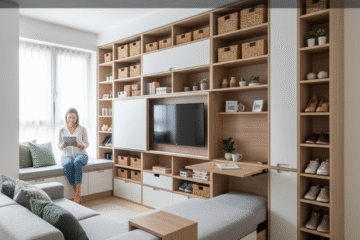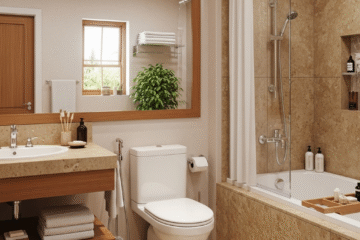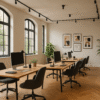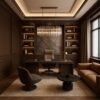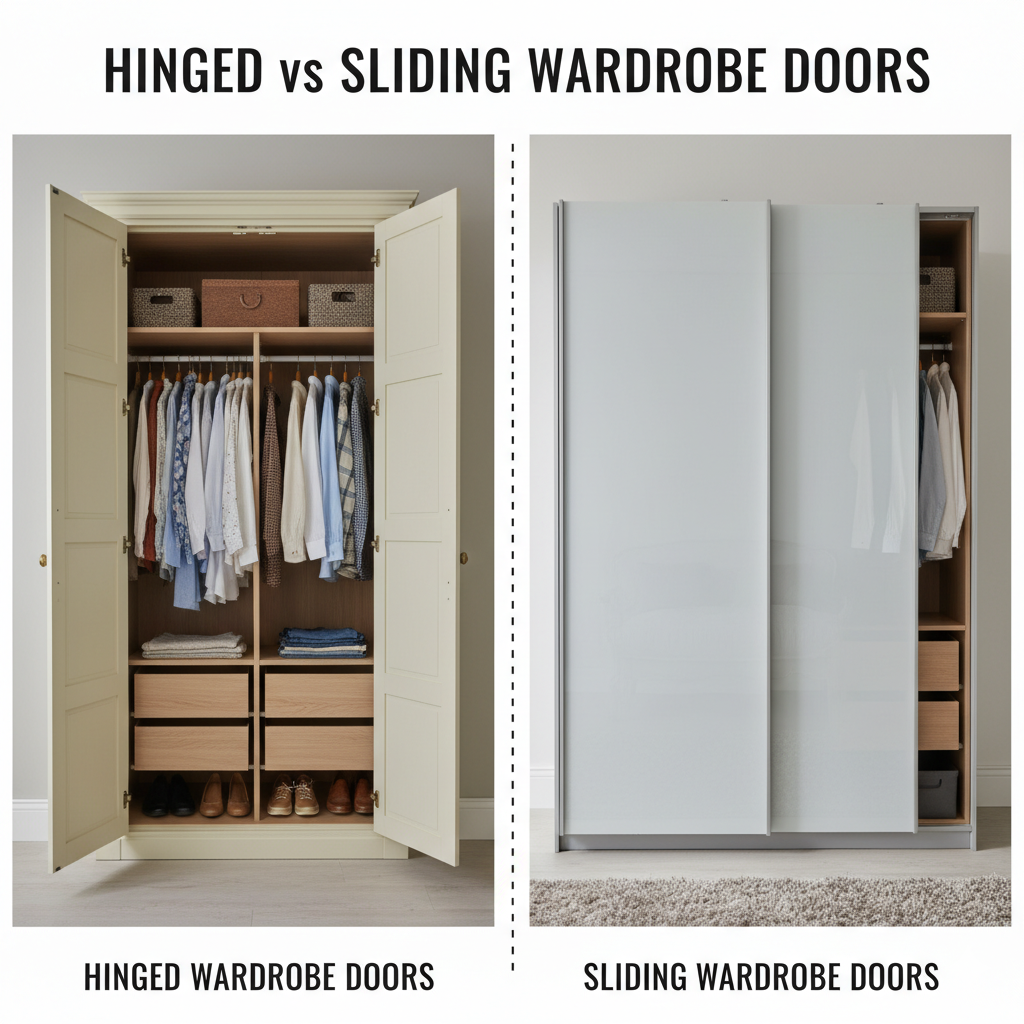
Hinged vs Sliding Wardrobe Doors – Which is Best for Your Home?
Choosing the right wardrobe door style can completely transform the look, feel, and functionality of your bedroom. In the world of modular furniture, hinged vs sliding wardrobe doors is one of the most debated comparisons among homeowners, designers, and contractors. The right choice depends on your space, lifestyle, and aesthetic goals — and that’s exactly what we’ll help you decide today.
Table of Contents
🪞 Why Your Wardrobe Door Choice Matters
Your wardrobe isn’t just a storage unit — it’s a key design element in your room. Whether you opt for hinged or sliding doors, each style brings a unique blend of style, convenience, and space management. The wrong choice could leave you dealing with daily inconveniences, while the right one can elevate your interiors for years.
If you’ve been exploring modular wardrobes, you’ve probably already seen countless sleek sliding options or timeless hinged designs. But which truly suits you? Let’s break it down.
🛠 Understanding the Basics: Hinged vs Sliding Wardrobe Doors
Before comparing pros and cons, it’s important to understand the difference:
Hinged Wardrobe Doors
Hinged wardrobe doors are the most traditional and timeless option in home interiors. These doors are attached to the wardrobe frame with conventional hinges and swing outward, usually opening to an angle of 90–120 degrees, depending on the hinge type and available clearance. The greatest advantage of hinged doors is the full visibility they provide, as the entire wardrobe interior can be accessed at once without obstruction.
This style also allows for flexibility in design, as the doors can be finished with laminates, acrylics, mirrors, glass, or even decorative moldings to match the overall theme of the room. Hinged doors also offer the option of adding pockets, hooks, or hanging racks on the inside for belts, scarves, and ties.
However, they require ample floor space in front of the wardrobe to open fully, which may not be practical in smaller bedrooms. Despite this, hinged wardrobes remain a preferred choice for those who prioritize accessibility and classic styling.
Sliding Wardrobe Doors
Sliding wardrobe doors are a modern and space-saving alternative that operate on a smooth track system, gliding horizontally across the wardrobe frame. Unlike hinged doors, sliding doors do not need outward clearance, making them an ideal solution for compact bedrooms, studio apartments, and urban homes where space efficiency is a priority.
Their sleek and streamlined design gives them a contemporary aesthetic, often preferred in minimalist and modern interiors. Sliding doors also provide opportunities for creative finishes, such as frosted or tinted glass, high-gloss laminates, or a combination of wood and mirror panels, adding both style and functionality.
While sliding wardrobes maximize floor space, one limitation is that only one section of the wardrobe can be accessed at a time, since the panels overlap when opened. Regular maintenance of the sliding track system is also essential to ensure smooth operation over time.
✅ Together, hinged and sliding wardrobes cater to different lifestyle needs. Hinged doors excel in accessibility and traditional charm, while sliding doors provide a modern, space-efficient solution. Choosing between the two depends largely on room size, personal style preferences, and functional priorities.
Knowing these basics will help you evaluate functionality, space requirements, and style potential.
Explore Modular Wardrobe Options Today
Discover the perfect hinged or sliding wardrobe designs tailored to your space.
✅ Advantages of Hinged Wardrobe Doors
Hinged wardrobes have been the classic choice for decades. Here’s why they’re still popular:
Full Interior Access
One of the most practical advantages of hinged wardrobe doors is the ability to open all doors simultaneously, giving uninterrupted access to the entire wardrobe interior. This feature makes it easy to organize, clean, or retrieve multiple items at once without having to shift panels back and forth. For households where wardrobes double as storage for clothing, accessories, and seasonal items, full access ensures convenience and efficiency.
Better Corner Fit
Hinged wardrobes are especially well-suited for L-shaped or corner wardrobes, where sliding tracks may not operate efficiently due to alignment issues. The swing mechanism of hinged doors allows them to adapt to unusual angles and layouts, ensuring no wasted space in compact or irregularly shaped bedrooms. This makes hinged wardrobes a versatile solution for both traditional and modern homes.
Easier Repairs
Hinges are simple in design and much easier and cheaper to repair or replace compared to the sliding track systems used in modern wardrobes. Over time, sliding doors may develop alignment issues, get stuck, or require costly maintenance. Hinged doors, on the other hand, usually only need a hinge replacement or tightening, making them a low-maintenance and long-lasting choice.
Design Flexibility
Hinged wardrobes offer endless design possibilities. From sleek, minimal laminates to ornate moldings, carved panels, or decorative handles, the surface of a hinged door can be fully customized. They are also compatible with bold finishes like mirrors, glass inserts, or PU paint, allowing homeowners to align the wardrobe design seamlessly with their overall interior style. This flexibility makes hinged doors a favorite among those who want a wardrobe that doubles as a statement piece in the bedroom.
Accessories Friendly
Unlike sliding wardrobes, hinged doors allow for functional accessories like hooks, tie racks, or even slim organizers to be mounted on the back of the door. This adds extra storage for belts, scarves, ties, or bags, maximizing the utility of the wardrobe. For families or individuals with a variety of accessories, this feature ensures organization without cluttering the main storage compartments.
✅ In summary, hinged wardrobe doors remain popular because they combine functionality, design versatility, and ease of maintenance. They work particularly well in larger rooms or unconventional layouts where space isn’t a constraint and where design personalization is a priority.
🔄 Advantages of Sliding Wardrobe Doors
Sliding wardrobes have become a favorite in contemporary modular furniture projects, especially for compact spaces.
When it comes to wardrobe design, understanding the pros and cons of hinged vs sliding wardrobe doors is essential for functionality, aesthetics, and space optimization. Both options have unique advantages, and selecting the right type can significantly improve your room layout, usability, and interior design appeal. Let’s explore why homeowners should carefully evaluate hinged vs sliding wardrobe doors for their spaces.
1. Space-Saving Benefits of Sliding Doors
One of the main considerations when comparing hinged vs sliding wardrobe doors is space efficiency. Sliding doors do not require a swing radius, making them perfect for compact bedrooms, apartments, or shared rooms. Unlike hinged doors that need clearance to open fully, sliding panels glide along tracks, allowing for placement of furniture and free movement in tight spaces. This makes sliding doors a smart choice when evaluating hinged vs sliding wardrobe doors for small or multifunctional rooms.
2. Sleek, Modern Look with Sliding Doors
Another factor in the hinged vs sliding wardrobe doors debate is visual style. Sliding doors often come in large, uninterrupted panels that create a clean and minimalist aesthetic. Their seamless appearance complements contemporary and modern interiors, giving rooms a polished and sophisticated look. If style and elegance are priorities, sliding doors usually edge out hinged doors when comparing hinged vs sliding wardrobe doors in terms of design impact.
3. Mirror Integration for Dual Functionality
When choosing between hinged vs sliding wardrobe doors, mirror integration is a significant advantage. Sliding doors can incorporate full-length mirrors, serving both as functional dressing mirrors and as a design element that enhances room brightness and perceived space. This feature is harder to achieve with traditional hinged doors without additional wall space, making sliding doors a more versatile option in the hinged vs sliding wardrobe doors comparison.
4. Wider Panels Enhance Aesthetics
Sliding wardrobes often feature fewer, wider panels, creating a smooth, uninterrupted look. This reduces visual breaks and makes the wardrobe appear larger and more cohesive. In discussions about hinged vs sliding wardrobe doors, this aesthetic advantage is a key reason many homeowners prefer sliding doors in bedrooms or walk-in closets. Wide panels also allow for integrated designs like textured laminates, glass inserts, or decorative finishes, further enhancing the interior appeal.
5. Smooth and Silent Operation
Quality sliding mechanisms make daily use of wardrobes effortless. When comparing hinged vs sliding wardrobe doors, smooth operation and quiet gliding are important for households with multiple users or shared rooms. Modern sliding systems are designed to reduce friction, prevent door misalignment, and ensure longevity, giving sliding doors a practical advantage over hinged doors in terms of ease of use and maintenance.
6. Additional Considerations for Hinged vs Sliding Wardrobe Doors
When designing wardrobes, understanding the specific advantages for hinged doors is essential for both functionality and aesthetic appeal. While sliding doors maximize space, for hinged doors, there are unique benefits that make them suitable for certain room layouts and design preferences.
1. Full Access Advantage for Hinged Doors
A primary benefit for hinged doors is the ability to open the entire wardrobe at once. Unlike sliding doors, which only reveal a portion of the storage at a time, for hinged doors, homeowners can access all shelves, drawers, and hanging sections simultaneously. This feature for hinged doors is particularly useful in larger bedrooms or walk-in closets, where space is not a constraint and a classic interior style is preferred.
2. Complementing Classic Interior Styles
When evaluating wardrobes for hinged doors, these doors fit seamlessly with traditional, vintage, or ornate interiors. Full-access panels for hinged doors allow for detailed designs, wood carvings, or decorative laminates to be fully appreciated. Designers often choose for hinged doors in spaces where aesthetic detailing matters, ensuring that functionality and style coexist effortlessly.
3. Material Choices for Hinged Doors
For durability and style, the materials used for hinged doors play a crucial role. Laminates, glass, wood veneers, or mirrored panels can all be applied for hinged doors to achieve a specific look while maintaining resilience. Selecting the right finish for hinged doors ensures longevity, ease of maintenance, and visual harmony with the rest of the room. High-quality materials for hinged doors can elevate a standard wardrobe into a premium design feature.
4. Maintenance Considerations for Hinged Doors
Maintaining wardrobes for hinged doors is straightforward but essential for long-term performance. Hinges should be regularly lubricated for hinged doors to prevent squeaking and ensure smooth opening. Compared to sliding doors, which require track cleaning, for hinged doors, routine checks of alignment and hinge quality keep wardrobes functional and visually appealing over time.
5. Integrating Hinged Doors with Modern Interiors
While sliding doors are often chosen for space-saving and mirror integration, wardrobes for hinged doors can still incorporate modern elements. Adding slim-profile handles, LED lighting, or glass panels for hinged doors allows them to blend classic design with contemporary features. This flexibility for hinged doors makes them a viable option in both traditional and modern interiors, depending on room layout and personal preferences.
6. Balancing Space and Access
When deciding for hinged doors, it’s important to consider available room space. Unlike sliding doors, for hinged doors, a clearance area is necessary for full access. Proper planning for hinged doors ensures that opening panels do not obstruct furniture, walkways, or adjoining walls. Thoughtful placement for hinged doors maximizes functionality without compromising aesthetics.
⚖️ Hinged vs Sliding Wardrobe Doors – Detailed Comparison
| Feature | Hinged Doors | Sliding Doors |
|---|---|---|
| Space Requirement | Needs clearance for door swing | Saves floor space |
| Visibility | Full wardrobe visibility | Only one side open at a time |
| Aesthetics | Works with traditional and modern | Best for contemporary, minimal look |
| Durability | Hinges are long-lasting & low-maintenance | Tracks may need periodic maintenance |
| Customization | More handle & design options | Limited to sleek, flat designs |
| Cost | Often more budget-friendly | Can be costlier due to track & mechanism |
🏠 Which One Should You Choose?
When deciding between hinged vs sliding wardrobe doors, consider:
Room Size
The size of your bedroom plays a crucial role in deciding between hinged and sliding wardrobe doors. For compact or small-sized bedrooms, sliding wardrobe doors are an excellent option since they open horizontally along tracks, saving valuable floor space. This ensures you can place your bed, side tables, or seating closer to the wardrobe without worrying about clearance for door swing. On the other hand, hinged doors require more space to open outward, making them more suitable for medium to large bedrooms where floor area is not a constraint.
Usage
Your personal usage preference also matters. If you prefer viewing your entire wardrobe at once, hinged doors are the better choice as they allow all doors to open simultaneously, giving full visibility and easy access. This is especially convenient for those with large clothing collections or multiple storage compartments. Sliding doors, however, only open one section at a time, which may be slightly less convenient if you frequently need to access different areas of your wardrobe quickly.
Design Theme
The overall theme of your interiors should guide your choice as well. Sliding doors are often associated with modern, minimal, and contemporary design aesthetics, offering a sleek and streamlined look. They can also be customized with mirrors, glass, or glossy finishes for a chic appearance. In contrast, hinged doors are better suited for traditional or classic interiors, where ornate designs, detailed moldings, or handles complement the overall décor. They blend well in settings that emphasize heritage, warmth, or timeless design.
Budget
Budget is a deciding factor for many homeowners. Hinged doors are generally more affordable upfront because they require simpler hardware and mechanisms. The cost of hinges and standard panels is lower compared to the sliding tracks and rollers used in sliding wardrobes. However, sliding wardrobes may offer long-term space efficiency, which can be seen as a value addition in compact homes. If you’re working with a limited budget, hinged wardrobes might be the more cost-effective option, whereas sliding wardrobes are worth considering as a long-term investment in style and functionality.
✅ In summary, choosing between hinged and sliding wardrobe doors depends on a combination of room size, personal usage habits, design preferences, and budget considerations. By weighing these factors, homeowners can select the solution that balances functionality, aesthetics, and cost-effectiveness for their unique living space.
Get a Free Design Consultation
Talk to our experts and find out which wardrobe style suits your home best.
🎯 Expert Tip from Interior Grid
For modular wardrobe projects, our experts often blend both styles in the same home. For example, use sliding doors for master bedrooms with limited space, and hinged doors for guest rooms or walk-in wardrobes.
You can also explore our detailed guides:
💡 Space-Saving & Styling Tips
When designing wardrobes, understanding the differences for hinged doors versus for sliding doors is crucial. Each type of wardrobe door offers distinct advantages, and planning for hinged doors ensures optimal functionality, aesthetics, and convenience. This guide provides detailed insights for hinged doors to help homeowners make informed interior decisions while balancing style and practicality.
1. Slim-Profile Handles for Hinged Doors
A key consideration for hinged doors is handle design. Using slim-profile handles for hinged doors prevents accidental bumps into furniture or walls, making daily use smoother and safer. Homeowners focusing for hinged doors should prioritize ergonomics, ensuring handles are easy to grip while minimizing protrusion. Proper handle placement for hinged doors not only improves accessibility but also protects surrounding décor and maintains a clean, professional look.
2. Premium Tracks vs Hinged Doors
While sliding doors rely on premium tracks for smooth operation, wardrobes for hinged doors avoid this issue entirely. For hinged doors, the focus is on durable hinges and proper alignment for hinged doors. Investing in high-quality hinges for hinged doors ensures long-lasting functionality, smooth movement, and prevents sagging over time. Designers recommending solutions for hinged doors often prioritize hardware longevity and minimal maintenance compared to sliding alternatives.
3. Mirror Integration for Hinged Doors
Mirrored panels are highly effective for hinged doors. Full-length mirrors for hinged doors reflect light, enlarge visual space, and provide functional dressing areas. Unlike sliding doors, mirrors for hinged doors can be integrated without affecting door swing or accessibility. Interior designers planning wardrobes for hinged doors often suggest mirrored panels for hinged doors to add both style and practicality, making bedrooms brighter and more visually appealing.
4. Custom Interiors for Hinged Doors
Maximizing functionality for hinged doors requires well-planned interiors. Pull-out shelves, tie racks, shoe organizers, and integrated lighting are all essential for hinged doors to keep items organized and accessible. Planning storage solutions for hinged doors ensures that every inch of wardrobe space is efficiently utilized. Custom interiors designed for hinged doors can transform a standard wardrobe into a highly functional, visually cohesive piece that complements the rest of the room.
5. Clearance and Placement Tips for Hinged Doors
When planning wardrobes for hinged doors, sufficient clearance space is crucial. Hinged doors require room to open fully, so placement for hinged doors must avoid obstructing pathways, furniture, or adjacent walls. Proper clearance for hinged doors ensures comfort, ease of access, and prevents wear and tear. Designers advising homeowners for hinged doors emphasize the importance of accurate measurements and careful positioning to maintain usability over time.
6. Lighting Considerations for Hinged Doors
Illumination plays an important role for hinged doors. LED strips, overhead lights, and spotlighting for hinged doors enhance visibility and highlight wardrobe features. Designers recommend incorporating lighting solutions for hinged doors to improve functionality, aesthetics, and ease of use. Well-lit wardrobes for hinged doors make everyday access seamless and reduce the need for additional room lighting.
7. Material Choices for Hinged Doors
Material selection is critical for hinged doors. Laminates, wood veneers, glass, and mirrored panels all work effectively for hinged doors, offering durability, style, and ease of maintenance. High-quality materials for hinged doors ensure longevity, reduce repair needs, and maintain a polished look. Designers planning interiors for hinged doors often match finishes to the room’s overall décor to create a harmonious aesthetic.
📌 Pros & Cons Summary
Hinged Wardrobe Doors
Pros: Full visibility, versatile design, easy maintenance
Cons: Needs clearance space, not ideal for tight rooms
Sliding Wardrobe Doors
Pros: Space-efficient, modern appeal, large mirror options
Cons: Limited visibility, track maintenance required
💬 Final Word – Hinged vs Sliding Wardrobe Doors
If you prioritize space efficiency and a sleek look, sliding doors will likely win. But if full access and design flexibility matter more, hinged doors might be the better investment.
At the end of the day, your wardrobe door style should match your room’s proportions, your storage needs, and your personal taste.
🚀 Transform Your Wardrobe with Interior Grid
Whether you want custom modular hinged wardrobes or premium sliding wardrobes, Interior Grid connects you with the best designers and contractors in your city.
📞 Post your requirement today and get tailored quotes from trusted professionals.
Compare Prices and Features
See detailed cost comparisons to choose the most practical and stylish wardrobe solution.

